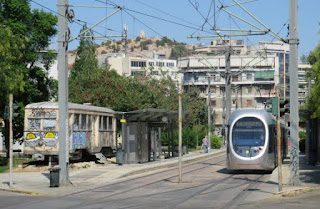In Athens city centre, buses and trolleybuses are the most visible means of public transport. These are operated by OSY (website only in Greek).
The trolleybuses operate a small number of routes. Trolleybuses carry a livery of yellow with blue or purple.
 Some of the trolleybuses are articulated...
Some of the trolleybuses are articulated...

 ... while others are standard length.
... while others are standard length.






Standard trolleybuses have three sets of doors.
The articulated vehicles have four.

The trolleybuses do have auxiliary engines which enable them to be driven without electric power.
Although it was under wires, this one had its power poles lowered and was using its auxiliary engine.
In Athens, buses are more numerous than trolleybuses. Most buses carry a white livery with yellow and blue.
 I found articulated buses with four sets of doors...
I found articulated buses with four sets of doors...







 ... and standard single-deckers with three sets.
... and standard single-deckers with three sets.






Some of the standard-length buses are gas-powered.
 These appear to be identifiable from their distinctive livery of green bubbles.
These appear to be identifiable from their distinctive livery of green bubbles.
 I also found some smaller buses operating on some routes in the city centre.
I also found some smaller buses operating on some routes in the city centre.These vehicles had two sets of doors.




Although Athens' metro system provides links to Athens airport, and to the port of Piraeus, these are complemented by express bus services.
 Route X95 operates from Syntagma Square, in the centre of Athens, to the airport.
Route X95 operates from Syntagma Square, in the centre of Athens, to the airport.Buses run 24 hours a day, 7 days a week, generally every 15-20 minutes.
I found articulated buses operating on the X95.



Route X80 to the port at Piraeus also operates from Syntagma Square. There is no all-night service on this route.
I found standard single-deck buses operating route X80.
 Athens has a modern tram system, linking the city with the coast.
Athens has a modern tram system, linking the city with the coast.The system opened in 2004, just in time for the Olympic Games which were hosted in Athens.





 In the city centre, the tram route terminates at Syntagma Square.
In the city centre, the tram route terminates at Syntagma Square.However, trams have been unable to reach their city centre terminus due to subsidence.
Approximately 2.5 kilometres of route are currently disused.




Trams are currently terminating at Kassomouli, with passengers using the metro to and from Syntagma.
At Kassomouli, a historic tram car serves as a temporary facility for drivers.
 The tram system is operated by STASY, who also operate the metro system.
The tram system is operated by STASY, who also operate the metro system.As in many cities, Athens' metro system is mainly below ground in the city centre.
However, even in the heart of Athens, there are some sections of the metro which are at surface level.
A couple of websites providing useful information for visitors to Athens about the city's public transport system include Athens Transport and This is Athens.
Fares on Athens' bus, trolleybus, tram and metro systems are fully integrated, and also include the suburban railway.
At the time of writing a single fare costs €1.40, and is valid for 90 minutes including interchanges. An all-day ticket is available for €4.50, while a 5-day pass costs €9. These fares do not include travel to or from the airport. For travel to and from the airport, special fares apply.
Longer period tickets are also available, with validity ranging from 30 days to 365 days. Full details are given on the Athena Card website.
One further transport system in Athens is a funicular railway. This climbs Lycabettus Hill, the highest hill in Athens.




The funicular, which is entirely in tunnel, is primarily for tourists and does not form part of the integrated public transport system.
 Bus services into Athens from points further afield are provided by KTEL Attikis.
Bus services into Athens from points further afield are provided by KTEL Attikis.



 The main terminals for KTEL services (and for long-distance and international coach services) are a little way out of Athens city centre.
The main terminals for KTEL services (and for long-distance and international coach services) are a little way out of Athens city centre.However there is also a small terminal at Victoria, closer to the centre of Athens.

For the many tourists visiting Athens, several companies offer hop-on, hop-off sightseeing tours with open-top double deck buses.
 Red vehicles operate under the City Sightseeing brand.
Red vehicles operate under the City Sightseeing brand.
 The buses operating under the Gray Line banner are pale green.
The buses operating under the Gray Line banner are pale green.


 The buses on the Sights of Athens tour are blue.
The buses on the Sights of Athens tour are blue.


 There is also a road train tour, Athens Happy Train.
There is also a road train tour, Athens Happy Train.Like the open-top bus tours, this operates as a hop-on, hop-off service.





Finally, some more disused tram tracks.
The opening of Athens' tram system in 2004 marked the return of this form of transport to the Greek capital. Trams had previously operated in Athens until 1960.
Tram rails are still set into the road surface on Makrigianni, close to the Acropolis.

No comments:
Post a Comment